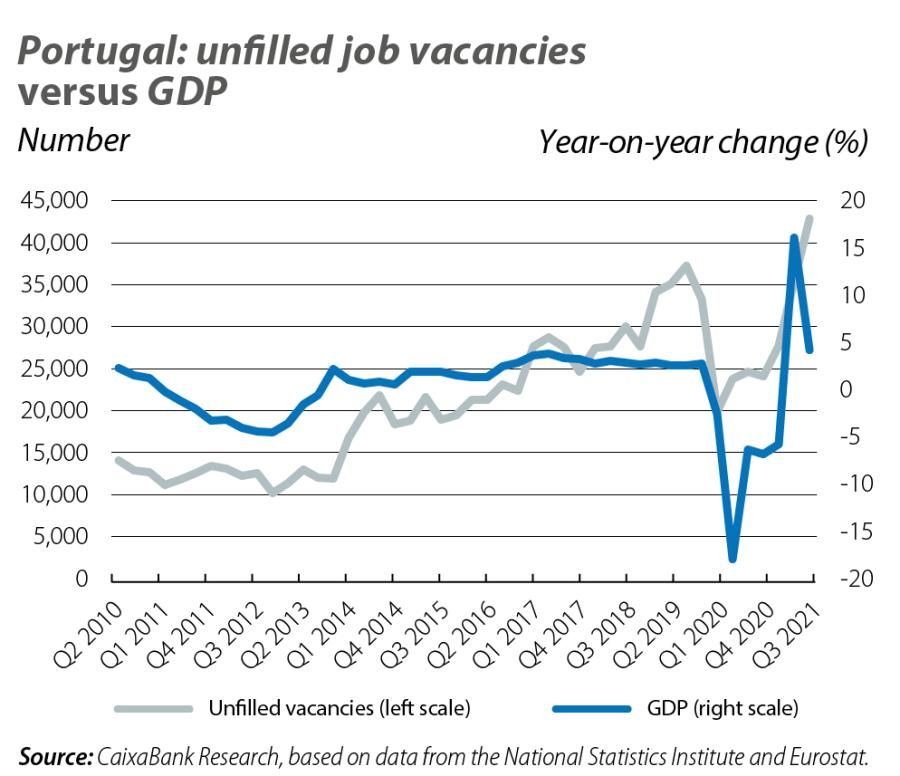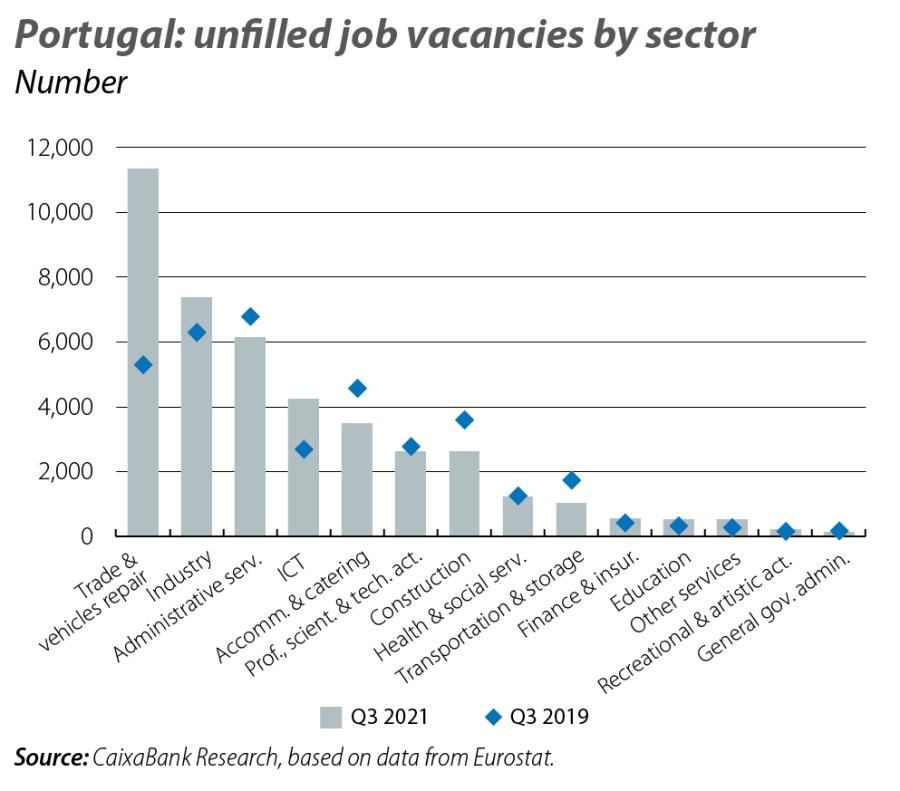
Why is there a lack of workers in Portugal?
Although the indicators point to a strong recovery in economic activity in the coming quarters, there are factors that could limit the speed of that recovery. These include the disruptions to global supply chains, resulting from transportation problems and some component shortages, and the energy crisis, with rising electricity prices and the consequent increase in production costs. Another factor, which has received less attention but may also limit the speed of the recovery, is the mismatch that has been generated between demand and supply in the labour market. In particular, unfilled job vacancies have grown steadily since the end of 2020 and in Q3 2021 exceeded 42,800, the highest level in the series. Industrial and construction companies cite labour shortages as an obstacle to them conducting their operations.
This increase in the number of unfilled jobs stands in contrast to the trend in economic activity, which despite experiencing a strong recovery still lies 2.4% below the same period in 2019.

The number of unfilled vacancies has increased in all sectors. It is particularly pronounced in the trade & vehicle repair, where the number of vacancies rose in Q3 to 11,300 job positions. This represents around 30% of the total job vacancies and is more than double the level registered in Q3 2019. Furthermore, vacancies in the manufacturing and ICT sectors not only show very high year-on-year growth (+91.8% and 64%, respectively), but already exceed pre-pandemic levels. In sectors such as transportation and storage or accommodation and restaurants, the number of vacancies are below pre-pandemic levels (–40.7% and –23.5%, respectively), but both of these sectors are experiencing strong growth of 14.6% and 147.5% year-on-year, respectively. The case of the accommodation and restaurants sector is even more striking, since – with the exception of 2019, the peak in the series driven by record levels of tourism in that year – the number of vacancies is the highest it has ever been, despite tourism activity still being below 2019 levels.1
- 1The number of guests in tourist accommodation establishments in Q3 2021 was 31.2% lower than in Q3 2019.

There are several factors that can explain this development. One of them relates to the mismatch in the labour market between the training required by companies and candidates’ qualifications, which may explain the increase in unfilled job vacancies in sectors such as ICT. The shortage of labour in these sectors is particularly concerning: COVID-19 has contributed to a sharp growth in remote working and the consumption of digital services, which has increased the demand for digital profiles. At the same time, foreign companies have been taking advantage of the use of teleworking by hiring professionals with skills in this field who are based in Portugal, exacerbating the shortage for local firms. However, this is not a problem unique to Portugal: in 2019, some 60% of European companies seeking ICT specialists experienced difficulties in filling their vacancies.2
Another reason may be the impact of the pandemic on immigration flows. The number of permanent immigrants, which had been growing since 2015, fell substantially in 2020 (–7.7%, equivalent to 5,565 fewer immigrants).3 The foreign labour force also fell in 2020 (–3.5%), breaking the upward trajectory initiated in 2018. Nevertheless, this pattern is mainly a response to a temporary situation, and the normalisation of activity should provide a new boost for these migration flows, mitigating the rise in unfilled vacancies in sectors such as accommodation and restaurants, administrative and support service activities, retail or even construction, which are the activities with the greatest presence of immigrant labour.
Finally, fears of the virus spreading among workers remain ever present and have a greater impact on sectors which involve more direct contact with people, such as accommodation and restaurants or social support activities. It is therefore possible that some people previously employed in these sectors may have sought employment elsewhere, in view of the health risk and the great uncertainty caused by the implementation of measures aimed at containing the pandemic. Moreover, we should not rule out the potential impact that changes in consumption patterns could have on the demand for certain types of professionals: as an example, the proliferation of e-commerce has contributed to greater demand in the transportation and logistics sector.4
Over the coming years, as the economy undergoes the transformation and digitalisation process, we can expect to see greater demand for workers with particular skills, especially in the STEM fields,5 such as data analysts, big data specialists or climate and environmental specialists. Also, the implementation of the RRP in such a short period of time can increase the shortage of human resources, especially in the construction sector. At the same time, it will be important to recycle workers currently performing more routine tasks, as some of this work will be automated in the future. In fact, it is estimated that around 40% of Europe’s workforce in 2018 will need to acquire new skills in the future, because more than 20% of the tasks they currently perform could be replaced by technology.
In this regard, the gap between supply and demand in the labour market may widen in the absence of policies that reverse this trajectory. It is therefore essential to improve the employability of workers by adapting the supply of academic and technical training to the needs of the labour market, as well as to create public programmes to help workers obtain qualifications or retrain in new areas. Such programmes already exist in the form of the Upskill programme (for retraining unemployed people in digital skills) and the Employment + Digital programme (for retraining people already in work). In parallel, it is key that companies play an active role and provide their employees with the means to update their skills. Incentives could also be put in place for immigrants, not only to alleviate the labour shortage but also to offset the ageing of the Portuguese population and to diversify its knowledge base.
- 2See European Commission (2021). «Joint Employment Report 2021».
- 3For further information, see ECB (2021). «Labour supply developments in the euro area during the COVID-19 pandemic». Economic Bulletin 7/2021.
- 4See McKinsey & Company (2021). «Navigating the labor mismatch in US logistics and supply chains».
- 5Acronym for Science, Technology, Engineering and Mathematics. A net job creation potential of 25% is estimated between 2018 and 2030 in Europe in this sphere. For further information, see McKinsey Global Institute (2020). «The future of work in Europe».


